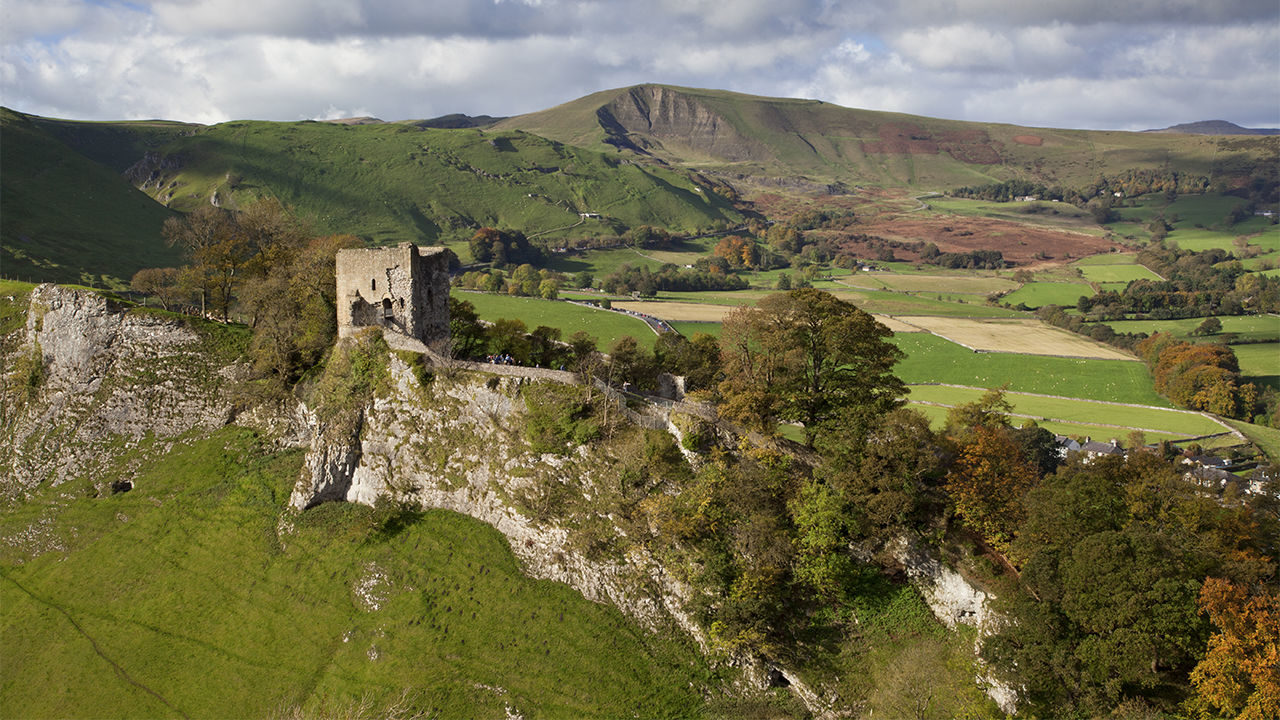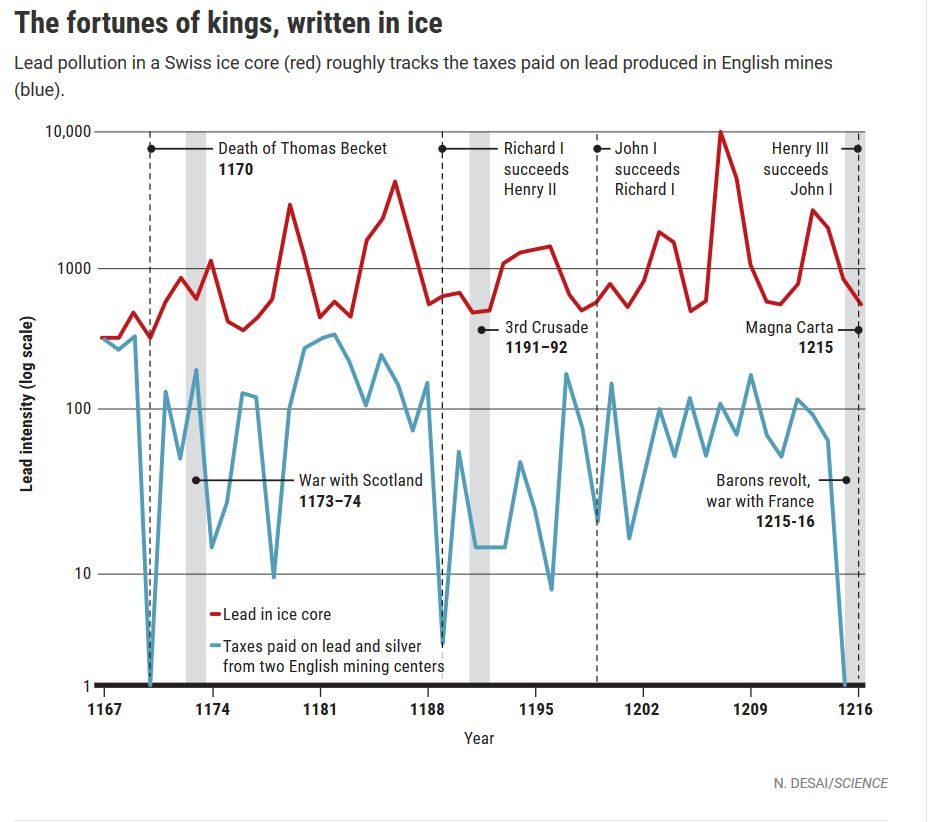
Here, farmers mined and smelted so much lead that it left toxic traces in their bodies — and winds blew lead dust onto a glacier 1500 kilometers away in the Swiss Alps. Loveluck and his colleagues say the glacier preserves a detailed record of medieval lead production, especially when analyzed with a new method that can track deposition over a few weeks or even days.
Lead tracks silver production because it is often found in the same ore, and the team found that the far-flung lead pollution was a sensitive barometer of the medieval English economy. As they report in a study published this week in Antiquity, lead spiked when kings took power, minted silver coins, and built cathedrals and castles. Levels plunged when plagues, wars, or other crises slowed mining and the air cleared. "This is extraordinary — lead levels correlate with the transition of kings," says historian Joanna Story of the University of Leicester, who was not part of the study.
Most people associate lead pollution with the Industrial Revolution, when lead became widely used in paints, pipes, and ceramics. But researchers have long known that the Romans also absorbed high levels of lead as they smelted silver and other ores. Recently, scientists have identified startling spikes of lead deposited in medieval times in Arctic ice cores and in lake sediments in Europe. A study last year suggested most of the pollution came from mines in Germany.
The new study, however, points to England. In collaboration with Loveluck and historians at Harvard University, glaciologist Paul Mayewski and his team at the University of Maine, Orono, analyzed lead in an ice core drilled in 2013 in the Colle Gnifetti Glacier in the Swiss Alps. The 72-meter-long core preserves more than 2000 years of fallout from pollution, volcanoes, and Saharan dust storms. To decipher this record at the highest possible resolution, the team used a laser to carve 120-micron slivers of ice, each representing just a few days or weeks of snowfall, along the length of the core. They analyzed the samples — some 50,000 from each meter of the core — for about a dozen elements, including lead.
The ice core data revealed dramatic lead spikes between 1170 and 1219 C.E. — "the highest levels of lead pollution before modernity," says historian Alexander More, of Harvard and Long Island University, Brooklyn. Lead levels matched those recorded in 1890, at the peak of the Industrial Revolution. (Lead in the core reached its max in the 1970s, spurred by leaded gasoline.)
To find the source of the medieval spikes, the team modeled how pollution travels on wind currents through Europe. The model showed that during the summer months, lead-laced winds blew to the glacier from the northwest — from Great Britain. Summer — between spring and fall harvests — was also when Peak District farmers mined the most lead. "You have women and children breaking the rocks and smelting the ore in Castleton, and the lead is getting picked up and transported over the western Alps," says historian Ann Carmichael of Indiana University, Bloomington.
Loveluck ground-truthed the model by scouring the English Pipe Rolls, historic scrolls that record annual taxes paid by miners for cartloads of lead. At a 2018 workshop at Harvard, the geoscientists and historians found they could match lead pollution in the Swiss ice core, taxes paid, and events in English history. For example, when Mayewski showed on a graph that lead pollution plummeted in 1170, Loveluck and Harvard historian Michael McCormick immediately knew why: "1170 was the year that Henry the II's assassins killed the archbishop of Canterbury [Thomas Becket] and Henry was excommunicated," Loveluck says. "Nobody paid any taxes." Mining stopped.
A decade later, lead pollution peaked. That's when Henry II had finally made up with the Pope and "began to bankroll the rebuilding of Cistercian abbeys," Loveluck says. "He has massive lead orders" for building roofs, gutters, and cisterns, which are reflected in taxes on mines in the Peak District and at Carlisle in Northern England.
Lead in the core surged again in 1193, when Richard I (the "Lionheart") was imprisoned in Germany by the Holy Roman Emperor Henry VI, who demanded a ransom. "There appears to be a very concerted effort to pay the ransom," McCormick says, which gave a turbo boost to lead and silver mining.
But Richard I left his successor and brother, John I, a depleted treasury. John lost Normandy in a war with France and was perceived as weak. Emboldened, his barons revolted in 1215, when John was forced to sign the Magna Carta, giving the church and barons more rights and reducing his ability to build castles, McCormick says. John died in 1216 and during the transition to Henry III, minting of coins — and mining — stopped. No lead taxes were paid and lead levels in the core plummeted.
For miners and their families, economic good times — when lead production spiked — may have also spurred devastating health effects, says Loveluck, who is part of an ongoing study of Castleton skeletons.
Other nations' mines may also have contributed to the surges in the ice core, cautions geochemist Paolo Gabrielli of Ohio State University, Columbus. And snow hydrologist Joe McConnell of the Desert Research Institute, part of the rival group that proposed that German mines were driving lead levels in Arctic ice cores, questions the precision of the new study. He notes that much of the snow that drops on Swiss glaciers is blown away, leaving an incomplete record in the ice.
One way to settle the debate would be to check mining records: McCormick says silver and lead mining peaked in the mines of the Harz Mountains in Germany before this period. Researchers also could study whether lead from English and German mines has distinctive isotopic signatures; if so, isotopes in the ice record could settle which region polluted most. Meanwhile, other teams are analyzing ice cores elsewhere in the Alps for lead spikes. "We've got to do this work fast, before all of these glaciers melt," Carmichael says.
Ann Gibbons is a contributing correspondent for Science. Follow her on Twitter @evolutionscribe




Reader Comments